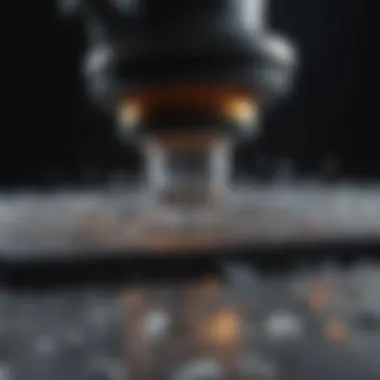Epi Illumination: Innovations in Scientific Imaging


Intro
Epi illumination is a fundamental advancement in optical microscopy, which significantly enhances the way researchers visualize and analyze specimens. This technique operates by illuminating the specimen from above through the same objective lens used for observation. As such, it allows for diverse applications across many scientific disciplines.
In recent years, developments in technology have broadened the capabilities of epi illumination, leading to more refined imaging processes, extracting vital details that were once difficult or impossible to observe. This article elucidates these advancements, providing a comprehensive analysis of both its principles and practical applications.
Background and Context
Overview of the Research Topic
Epi illumination stands as a key technique in the field of microscopy. The process involves directing light towards the sample from directly above, often utilizing techniques such as fluorescence or phase contrast microscopy. This approach offers significant advantages in terms of contrast and sensitivity, enabling the observation of cellular structures or materials in greater detail. Researchers can capture high-resolution images, which are critical for studies in cell biology, pathology, and materials science.
Historical Significance
The foundation of epi illumination can be traced back to the early developments in optical microscopy, particularly in the late 19th and early 20th centuries. Many pioneering scientists contributed to this field, enhancing the ability to view structures at a microscopic level. The introduction of fluorescence microscopy in the 1940s marked a pivotal moment, allowing visualizations of biological samples with enhanced clarity. Over the years, various technologies have evolved, including laser scanning and digital imaging, which have significantly influenced the sphere of microscopy and scientific research.
As technology progressed, the applications of epi illumination expanded. It now encompasses a range of techniques that cater to the needs of contemporary researchers, adapting to the complexities presented in studies of living organisms and materials.
Epi illumination has transformed the landscape of microscopy, offering researchers powerful tools for exploration and discovery.
As we delve deeper into the specifics of this technique, it becomes apparent just how crucial its advancements have been to scientific inquiry.
Preamble to Epi Illumination
Epi illumination plays a pivotal role in optical microscopy. It enhances the way we visualize specimens, allowing for a greater understanding of complex biological structures and materials. This technique is not just a minor advancement but a significant shift that has transformed many fields, enabling researchers to obtain clearer and more informative images. By utilizing specific lighting methods, epi illumination provides distinct advantages over traditional illumination techniques.
Understanding this topic is essential for students, researchers, educators, and professionals involved in scientific research. The effectiveness of imaging largely depends on the lighting configuration and how samples interact with light. Epi illumination addresses some of the shortcomings seen in other techniques, such as transmitted illumination, especially in terms of resolution and image clarity.
Definition and Overview
Epi illumination refers to a microscopy technique where the light source is positioned above the specimen. It directs illumination downward at the same angle as the objective lens captures light. This arrangement allows for effective imaging by collecting light that is reflected or emitted from the specimen. Thus, features that may be difficult to see with standard transmission techniques can be highlighted under this method.
This system can utilize various light types, including tungsten, mercury vapor, and lasers, which provide different wavelengths suited for specific imaging needs. The technique is particularly useful in fluorescence microscopy, where specific wavelengths excite fluorescent dyes attached to biomolecules, creating bright images against a darker background.
Historical Context
The concept of epi illumination can be traced back to the evolution of microscopy techniques. While early microscopes primarily relied on transmitted light, advances in light sources and optical components have allowed for the development of methods, including epi illumination. The first known use of epi fluorescent microscopy emerged in the mid-20th century, as researchers began to explore the potential of fluorescent markers in biological systems.
As researchers identified the limitations in other imaging modalities, they sought ways to improve image quality and resolution. Epi illumination provided an innovative approach, solving problems of contrast and background noise that limited earlier techniques. Today, it serves as a backbone for many modern microscopy methods, enabling detailed studies in biological research, materials science, and beyond.
"Epi illumination has revolutionized how scientists perceive and interact with intricate biological materials, allowing for greater discovery and insight."
In summary, epi illumination has evolved significantly, offering compelling solutions in imaging. As its technology advances, it continues to contribute profoundly to scientific research.
Theoretical Foundations
Epi illumination plays a foundational role in modern microscopy. Understanding the theoretical aspects behind this technique is essential for its effective application in scientific research. This section delves into the principles of light behavior and optics that underpin epi illumination. Mastery of these theoretical foundations enhances the competency of researchers in utilizing the technique, ultimately contributing to more precise and insightful results.
Fundamentals of Light Behavior
Light is a form of electromagnetic radiation visible to the human eye. Its behavior can be understood through several key properties including reflection, refraction, diffraction, and absorption. These properties are crucial for determining how light interacts with different materials in microscopy.
In epi illumination, the light source is positioned above the specimen. This arrangement alters the way light reflects off the sample. The key behaviors of light that are pertinent in this context include:
- Reflection: Light bounces off surfaces, and the degree of reflection varies with the angle and material properties.
- Refraction: When light travels from one medium to another, such as air to glass, it bends, which can affect the clarity of the image.
- Fluorescence: Certain materials can absorb light and then re-emit it at a different wavelength. This property aids significantly in imaging biological specimens.
By comprehending these behaviors, researchers can manipulate light more effectively to enhance image quality. Understanding light behavior is also vital in reducing artifacts that may arise during imaging, ensuring more reliable and reproducible results.
Optics in Epi Illumination
Optics refers to the study of light and its interaction with materials. In the context of epi illumination, optics plays a critical role in how images are formed and manipulated in microscopy. Key optical components involved include lenses, filters, and mirrors, each contributing to the efficacy of this imaging technique.


- Lenses: Convex and concave lenses are used to focus light onto the specimen and gather the emitted light. Proper lens selection is crucial for maximizing resolution and contrast in the images.
- Filters: These are employed to selectively allow certain wavelengths of light to reach the detector. Such specificity is essential for fluorescence imaging, where particular colors indicate specific biological components.
- Mirrors: Reflective surfaces are used to direct light towards the specimen. The arrangement of mirrors can influence the paths of light rays, impacting the final image quality.
Ultimately, a firm grasp of optics enables scientists to configure their microscopes for various applications, tuning the system for optimal performance. This knowledge is particularly valuable when integrating new technological advancements into traditional epi illumination setups.
The effective application of understanding light behavior and optics in epi illumination can greatly enhance the quality of scientific images, leading to better analysis and pioneering discoveries.
Mechanisms of Epi Illumination
Epi illumination serves as a foundation in various imaging techniques, overshadowing traditional methods with its unique approach to specimen visualization. Understanding the mechanisms behind epi illumination is crucial for appreciating its advantages in microscopy. This section will explore key elements like lighting configurations and sample interaction, which are fundamental to its operation and efficacy.
Lighting Configurations
Lighting configurations play a crucial role in the effectiveness of epi illumination. The primary concept involves directing light from above the specimen rather than from underneath, as is common in transmitted illumination. This alteration in the source of light leads to distinct imaging results that enhance visibility.
Epi illumination can be implemented in various configurations, tailored for specific applications. Here are some key configurations:
- Direct Epi Illumination: Light is focused directly onto the specimen. This method is beneficial for bright-field imaging, providing high contrast in certain types of samples.
- Fluorescence Epi Illumination: This technique utilizes specific wavelengths to excite fluorescent molecules within the specimen. The emitted light is then captured to form an image, making it a popular choice in biological research.
- Phase Contrast Epi Illumination: It enhances the visualization of transparent specimens without the need for staining. This is especially useful for live cell imaging.
By experimenting with these configurations, researchers can optimize their imaging methodologies based on specimen characteristics. This flexibility in adjustment helps overcome challenges associated with sample opacity and morphology, ultimately enabling clearer results.
Sample Interaction
The interaction between the light source and the sample is a pivotal aspect of epi illumination. The nature of the light interaction can significantly influence the quality and clarity of the resultant images.
Important aspects of sample interaction include:
- Reflection: In many cases, structurally complex samples may reflect light differently. This variability can inform researchers about the surface properties of materials or biological cells.
- Absorption: Various materials absorb light with differing efficiencies. Understanding this property aids in the selection of wavelengths for optimal imaging.
- Fluorescence: When using fluorescent markers, the interaction becomes even more critical. The way in which a sample emits light can reveal information about cellular function, structure, or even the presence of specific molecules.
An effective understanding of these interactions allows for tailored imaging conditions. Adjusting parameters such as light intensity, angle of incidence, and wavelength can lead to more refined and informative images.
Effective sample interaction contributes significantly to the resolution and contrast in microscopy. This makes it essential for achieving accurate and reliable results in research.
Ultimately, the mechanisms of epi illumination—comprising lighting configurations and the nature of sample interaction—provide researchers with advanced tools for microscopy. Mastery of these concepts enriches the imaging process and expands the horizons of scientific exploration.
Comparative Techniques
Understanding the comparative techniques in optics is essential for scientists and researchers. It allows them to make informed decisions on method selection, particularly when dealing with the visualization of specimens. Epi illumination stands out because of how it integrates with various imaging techniques. The key benefits of comparative approaches include enhanced resolution, improved contrast, and varied applicability across different research areas. Highlighting these elements allows researchers to identify the optimal method for their specific needs.
Epi Illumination vs. Transmitted Illumination
When evaluating lighting techniques, it is imperative to compare epi illumination with transmitted illumination.
- Epi Illumination: In this technique, light is directed onto the specimen from above, and the emitted light is captured for imaging. This approach is particularly effective for observing surface features and fluorescence in samples. One significant advantage is that background illumination does not interfere with the signal, resulting in high-quality images.
- Transmitted Illumination: Conversely, transmitted illumination uses light that passes through the specimen. This method is more suitable for transparent samples, such as biological cells in culture. While it provides clear visuals of internal structures, it may fail to capture details on the surface effectively, making it less versatile than epi illumination.
In summary, the crucial differences lie in their application and the type of information each technique reveals. Most studies that require surface details leaned towards epi illumination due to its sensitivity in detecting fluorescence, while transmitted illumination serves well for studying the internal architecture of clearer samples.
Integration with Other Imaging Modalities
The fusion of epi illumination with various imaging modalities is of great importance in advancing our understanding of complex samples.
- Combining Techniques: Epi illumination harmonizes well with techniques such as Electron Microscopy (EM) and Magnetic Resonance Imaging (MRI). Such integration allows for complementary insights, enhancing both spatial resolution and contrast.Rich data sets emerge from combining these modalities, offering richer narratives in research findings.
- Applications: For instance, in biological research, combining epi illumination with fluorescence techniques enables multi-channel imaging. This process allows for the investigation of multiple cellular components simultaneously. Researchers can analyze protein interactions or observe cell behavior in real-time, maximizing the information extracted from each experiment.
Overall, integrating epi illumination with other imaging methods broadens research capabilities. It opens avenues for discovery across disciplines, making it indispensable in contemporary scientific practices.
"The future of imaging lies in the combination of methodologies, as it allows for a more profound understanding of complex systems."
These comparative techniques emphasize the significance of choosing the right method for specific research goals, contributing to overall advancements in scientific study.
Applications Across Disciplines
The applications of epi illumination are vast and span across various scientific disciplines. This technique is particularly significant in both biological research and material science. In each of these areas, epi illumination enhances visualization capabilities, providing researchers with precise imagery that aids in their investigations. Understanding how these applications function contributes to a deeper appreciation of the utility of epi illumination in modern science.
Biological Research


Cell Imaging
Cell imaging represents a core aspect of biological research, critically contributing to the understanding of cellular processes. This technique allows scientists to observe living cells in real-time, revealing dynamic processes such as cell division and migration. One key characteristic of cell imaging using epi illumination is its ability to capture high-contrast images against a dark background. This distinct feature makes it a popular choice among researchers aiming to visualize specific cell components with clarity.
The unique benefit of this approach is its application in live cell imaging, which provides insights into the behavior of cells in their natural environment. However, there are disadvantages, such as the potential for phototoxicity, where excessive light exposure can damage the cells being observed. This aspect necessitates careful dose management of illumination to minimize impact on cellular health.
Fluorescence Techniques
Fluorescence techniques are another crucial facet of biological research. They leverage the property of certain molecules to emit light upon excitation, allowing for the visual tracking of specific biomolecules within cells. The ability to tag and visualize proteins or nucleic acids makes fluorescence a key tool for researchers exploring cellular functions at a molecular level.
A noteworthy characteristic is the sensitivity of these techniques, as they can detect very low concentrations of fluorescently labeled targets. This sensitivity is what makes fluorescence techniques beneficial; they provide researchers with the ability to study specific interactions and pathways that would otherwise remain undetected. Nonetheless, challenges exist, such as the potential for photobleaching where fluorescent signals fade over time, which can limit the duration of observation.
Material Science
Surface Characterization
Surface characterization is another area where epi illumination proves invaluable. It involves analyzing the properties of material surfaces to understand their structure and behavior. Epi illumination enhances this process by providing detailed visual information about surface morphology and composition.
The central feature of surface characterization through this method is its focused illumination, which allows researchers to examine surface features with high resolution. This advantage is critical for industries that rely on precise surface properties, like electronics or coatings. However, one disadvantage is the reliance on surface cleanliness; contaminants can interfere with imaging quality, leading to inaccurate analyses.
Nanostructure Analysis
Nanostructure analysis also benefits from the capabilities of epi illumination. This technique enables the visualization of materials at the nanoscale, which is essential for developing advanced materials with unique properties. The clear imaging of nanostructures allows researchers to explore phenomena that dictate material behavior at extremely small scales.
A key characteristic of nanostructure analysis is its ability to reveal complex structures and their interactions. This feature is beneficial for innovations in nanotechnology, where the understanding of nanoscale interfaces is crucial. However, challenges include the complexity of sample preparation and potential heat effects from illumination, which might alter the sample structure during analysis.
Epi illumination is not only significant in biological research but also stands as a pillar for advancements in material science, demonstrating its broad relevance across scientific fields.
Technological Advancements
The field of epi illumination has undergone significant technological advancements in recent years. These developments have expanded the capabilities of optical microscopy and enhanced the precision of imaging techniques. Understanding these enhancements is crucial for researchers seeking to maximize their investigative potential.
New Developments in Equipment
Recent innovations in microscopy equipment have led to notable improvements in epi illumination techniques. New light sources, such as LED and laser systems, provide higher intensity and greater spectral tuning options. This flexibility allows researchers to select precisely the wavelength that is optimal for their specific sample.
Moreover, camera technology has advanced. Sensors are now capable of capturing high-resolution images at faster rates. This is especially useful when analyzing dynamic processes in live specimens. The synergy between advanced imaging detectors and epi illumination has resulted in improved clarity of the samples, leading to more accurate interpretations.
Additionally, manufacturers like Zeiss and Nikon have introduced modular setups that enable rapid adjustments between different imaging modes. Such systems not only enhance usability but also support multifaceted imaging strategies, integrating fluorescence with brightfield imaging seamlessly.
Software Innovations for Imaging
Software plays a crucial role in the functionality of modern epi illumination systems. With the growth of computational imaging techniques, sophisticated algorithms are now employed to enhance image quality. For instance, deconvolution software can significantly reduce noise and improve resolution, making even the slightest details more discernible.
Another notable trend is the development of real-time image processing applications. These allow researchers to visualize and manipulate images as they are captured. For example, the use of machine learning in imaging can automate the identification of specific cellular structures, thus saving valuable time in analysis.
Furthermore, cloud-based platforms have emerged. They enable the storage and sharing of vast amounts of imaging data efficiently. This fosters collaboration among researchers by allowing them to access and analyze shared data without the constraints of physical location.
"The synergy of software innovations and hardware enhancements has transformed the landscape of epi illumination, allowing for unprecedented insights in scientific research."
Case Studies in Epi Illumination
When discussing the advancements and applications of epi illumination, case studies serve as a vital resource. They illustrate how this technique has been implemented successfully in various fields, offering insights into its practical applications and advantages. These case studies highlight the real-world impact of epi illumination, demonstrating both the depth and breadth of its utility in scientific research.
Epi Fluorescence in Cancer Research
Epi fluorescence has emerged as a powerful tool in cancer research. This method enhances the visibility of cellular structures and molecular interactions by utilizing fluorescent labeling. For instance, researchers can tag specific proteins involved in tumor growth or metastasis, allowing for precise localization within cells. Recent studies have shown that using epi fluorescence can significantly improve the detection sensitivity of cancerous cells compared to traditional techniques.
Moreover, this technique allows for real-time imaging, providing critical insights into how cancer cells interact with surrounding environments. By analyzing these interactions, scientists can develop targeted therapies that disrupt these processes. This real-time aspect is crucial in understanding cancer progression and testing new drugs effectively.
Some challenges still remain, including the need for proper controls and the potential for photobleaching during prolonged exposure. However, advancements in laser technologies and imaging systems are addressing these concerns, making epi fluorescence a mainstay in cancer research labs worldwide.
Material Applications in Semiconductor Research


Epi illumination also finds significant applications in semiconductor research. This sector heavily relies on the ability to analyze materials at the microscopic level, which is critical for the development of smaller, more efficient components. Epi illumination allows researchers to assess surface properties of semiconductors effectively, offering insights that traditional techniques may miss.
For instance, researchers can analyze defect structures in silicon wafers crucial for their performance. This analysis assists in optimizing manufacturing processes that directly affect the efficiency and reliability of electronic devices. Moreover, with the growing relevance of nanotechnology, epi illumination enables the examination of nanostructures, helping scientists explore new materials and configurations.
One of the benefits of using epi illumination in this context is its reliance on non-invasive techniques, which preserve the integrity of samples during examination. As technology progresses, the merger of epi illumination with other imaging methods can lead to even greater insights, enhancing our understanding of semiconductor materials.
In summary, the case studies exemplify the versatility and significance of epi illumination in various research contexts. They demonstrate how this technique has revolutionized our understanding of biological processes in cancer research and enhanced the examination of materials in semiconductor development.
Challenges of Epi Illumination
Epi illumination, while a powerful tool in optical microscopy, faces several challenges that researchers must navigate. Understanding these challenges is vital, as they can significantly impact the quality and accuracy of imaging results. This section delves into two prominent issues: artifacts in imaging and limitations in resolution. By exploring these challenges, researchers can better mitigate their effects and enhance the reliability of their findings.
Artifacts in Imaging
Artifacts are distortions or inaccuracies that appear in imaging and can mislead interpretations. In the context of epi illumination, multiple factors can contribute to the emergence of artifacts.
- Optical Elements: The lenses and filters used in the epi illumination setup can introduce optical aberrations. These distortions may affect sharpness and overall image quality.
- Fluorescence Background: Non-specific fluorescence can result from out-of-focus light, leading to a background that obscures the real signals from the specimen. This is particularly problematic when examining highly fluorescent samples.
- Sample Preparation: The methods used for sample mounting or staining can also produce artifacts. Improperly prepared samples may yield misleading results, complicating data interpretation.
Addressing these challenges involves careful optimization of imaging parameters and rigorously validating results against established controls. Researchers must remain vigilant in identifying potential sources of artifacts, ensuring the accuracy of their observations.
Limitations in Resolution
Resolution in microscopy refers to the ability to distinguish between two closely spaced objects. Epi illumination provides adequate resolution under optimal conditions, yet it has its intrinsic limitations.
- Diffraction Limit: The fundamental limit of diffraction plays a critical role in the resolution achievable with epi illumination. Light waves inherently spread, causing overlap between adjacent points that can appear as a single point in imaging. This phenomenon restricts the resolution beyond a certain point, typically around 200 nanometers.
- Technical Constraints: The configuration of the microscope also impacts resolution. For instance, the numerical aperture of the objective lens directly influences light-gathering ability and resolution. Higher numerical apertures provide better resolution but require precision in alignment and operational technique.
- Sampling Rate: Insufficient sampling during image capture can lead to loss of detail. If the image is not sampled at a rate high enough to capture variations in the specimen, important structural information can be lost.
To enhance resolution, many researchers are exploring techniques such as super-resolution microscopy. These methods push the boundaries of traditional imaging systems, offering improved insights into cellular and material structures.
"Understanding the underlying challenges of epi illumination is essential for advancing microscopy techniques and unlocking new research possibilities in various scientific fields."
Future Directions
The realm of epi illumination is ever-evolving, fostering new avenues of exploration. As advancements in technology and imaging techniques flourish, the future presents significant opportunities for enhancement in scientific research. Understanding these directions aids researchers and practitioners in adapting to upcoming methodologies and maximizing the potential within their fields.
The importance of this section lies in addressing how the ongoing progression within epi illumination impacts various sectors. This is not merely a matter of staying current; it encompasses novel insights and methodologies that may substantially influence research results and increase the accuracy of scientific inquiry.
Trends in Epi Illumination Research
Current trends in epi illumination research are shaped by advancements in optical technologies and imaging modalities. Some key trends include:
- Super-resolution Techniques: The development of super-resolution microscopy methods like STED or SIM allows for imaging beyond the diffraction limit of light. These techniques enhance the clarity of images, opening greater possibilities for biological and material science studies.
- Integration of AI and Machine Learning: The application of artificial intelligence in image processing workflows can improve analysis and facilitate automated recognition of specimens. This trend shows promise in enhancing both the speed and accuracy of data interpretation in research.
- Quantitative Imaging: Increasing focus on quantifying changes in fluorescent signals is a growing area. This trend enables researchers to draw more robust conclusions from their experimental data.
Overall, these trends reflect a shift towards more sophisticated and integrated approaches to imaging within the field of epi illumination.
Potential for New Applications
As technology advances, new applications for epi illumination are becoming evident in various fields. Here are notable areas of potential:
- Diagnostics in Medicine: Epi illumination techniques can be crucial in detecting cellular changes early in diseases. The potential for rapid, high-resolution imaging could transform diagnostics and targeted therapies.
- Environmental Monitoring: The visualization of structures at the nanoscale can lead to better understanding of pollutants and their impacts, allowing researchers to develop more effective environmental protection strategies.
- Nanotechnology: Epi illumination can enhance the study of nanoscale materials, providing insights that can drive the innovation of more effective materials and devices.
"The future is not something we enter. The future is something we create." - Leonard I. Sweet
Investigating these developments contributes to a wider understanding of epi illumination's role in modern research and paves the way for continued innovation in scientific exploration.
End
The conclusion serves as a critical element in the article, synthesizing key insights while emphasizing the importance of epi illumination in scientific research. By summarizing the various aspects explored throughout the text, it provides clarity and reinforces the relevance of this optical technique across multiple disciplines. Understanding how epi illumination enhances imaging methods is essential for researchers aiming to optimize their methodologies.
Summary of Key Insights
Epi illumination has proven to be a transformative technique within the realm of microscopy. Key insights from this discussion include:
- Enhanced Visualization: Epi illumination significantly improves the contrast and visibility of samples, particularly in biological contexts. This is particularly evident in fluorescence microscopy, where specific markers can be illuminated, making cellular structures more visible.
- Wide Applications: From biological research to materials science, the adaptability of epi illumination allows for a diverse range of applications. Researchers can employ this technique to study everything from live cell dynamics to the properties of nanostructures.
- Technological Advances: New developments in imaging equipment and software have expanded the capabilities of epi illumination. Innovations allow for greater resolution and improved imaging speed, which are crucial for time-sensitive research applications.
- Challenges and Limitations: While significant advancements have occurred, researchers must also navigate artifacts in imaging and limitations in resolution. Understanding these challenges is crucial for accurate interpretation of results.
Final Thoughts on Epi Illumination
In summary, epi illumination holds essential value in modern scientific inquiry. Its role in enhancing optical microscopy cannot be overstated. As research continues to evolve, the integration of newer technologies with traditional methods of epi illumination may yield unforeseen advancements.
The future appears promising, with a potential growth trajectory in both basic and applied research fields. New applications may emerge, further solidifying the significance of this technique in driving scientific discovery. Ultimately, for students, researchers, and educators alike, recognizing the advancements and challenges of epi illumination is key to leveraging its full potential in advancing knowledge.







